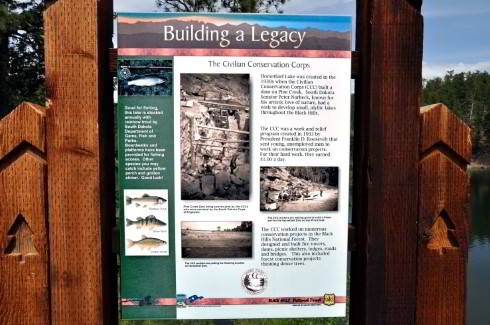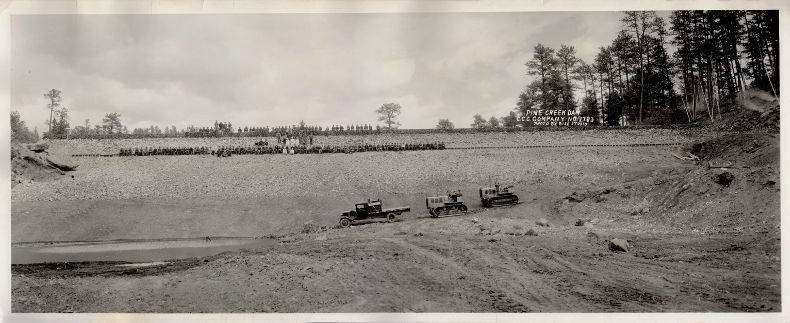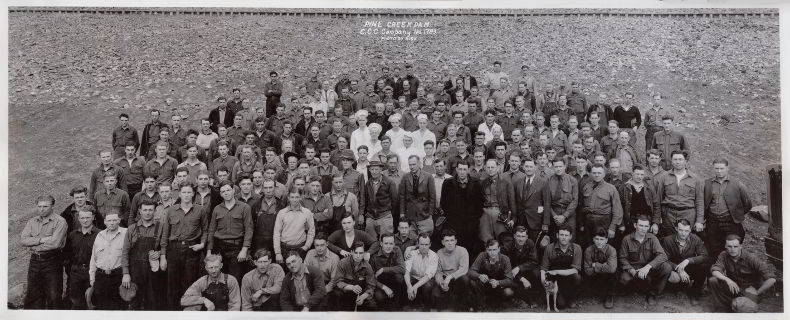Designation: SP-1 Date: 2018-12-31
Pine Creek
South Dakota Civilian Conservation Corps (CCC) camp Camp SP-1 was located 1 mile west and 1 mile north of Mount Rushmore, among the pine-covered hills of Pine Creek Canyon.

1933, 06/12 - 1936, 04/27, 1793
Date Closed: 1936, 04/27
Camp SP-1 was located 1 mile west and 1 mile north of Mount Rushmore, among the pine-covered hills of Pine Creek Canyon (1934).
When the camp was established it was impossible, because of the uneven terrain, to build on symmetrical lines. Buildings had to be located wherever possible with the result that the barracks were nearly in a circle and the officers' and foremen's quarters were a out 40 feet higher than the barracks. There was, however, sufficient room for all necessary buildings (1934).
The buildings included eight barracks, recreation hall, commissary, headquarters, hospital, laundry, bath house, mess hall, and officers' and foremen's quarters. All buildings were constructed of native rough lumber and lined with building paper (1934). Another barracks was built in 1934 and several other buildings were moved or remodeled (1935).
The camp was established June 12, 1933, and closed April 27, 1936.
Company 1793, the only company to be assigned to the camp, was assembled between May 30 and June 12, 1933, at Fort Meade. The company celebrated June 12 as the anniversary of its formation.
Work Achievements
A dam across Pine Creek was nearly completed in 1933. When finished it would form a scenic lake almost in the shadow of Mount Rushmore. The lake provided the Black Hills with a beauty spot, equaled perhaps, but not excelled, by any other in the area. Sponsored by Senators Norbeck and Bulow, the camp enjoyed every advantage in cooperation and use of equipment on the part of civil authorities (1934).

Mouseover (if your browser supports it) to zoom
From early spring in 1934 the chief work activities included cutting telephone posts and getting material for guard rails, general cleanup work, completion of the dam, building a double spiral (pigtail) bridge, construction of fire trails, extension of the Rushmore Memorial Highway, and developing springs as a landscape feature for use of tourists at camp sites (1935).
In August 1934 a 40-man side camp was established at Galena, the site of the present park headquarters. Men from this camp built the museum near the Game Lodge in Custer State Park. The dam across Pine Creek created Horsethief Lake. The lake had a shoreline of one mile and covered 17.92 acres. Picnic units were developed on the north and west shores. They included picnic tables and benches, outdoor stoves and fireplaces, shelters and water, and toilet facilities. A foot trail completely around the lake, joining the two picnic areas, was developed so that visitors could enjoy nature in all its naturalness (BHE).

Mouseover (if your browser supports it) to zoom
In the early part of January 1935 another side camp was established at Camp Lodge which formerly housed Company 2755. Forty men were stationed there—one of the best side camps in South Dakota. Those in the main camp built miles of guard rail, parking areas, and bridges or improved roads (1936).
A biennial report written by Camp Superintendent M. A. Garland, dated March 31, 1936, elaborated on the work.
The Camp Pine Creek was located in the northern hills of Custer State Park, which comprised 125,000 acres of virgin forest area, unusual in its rugged mountainous topography (MAG).
The purpose of the camp was, in general, to develop the northern area of the park which had become increasingly popular due to its proximity to Mount Rushmore National Memorial and such scenic areas as Iron Mountain, Sylvan Lake, and Elkhorn Mountain (MAG).
The main projects in the first year constituted the building of Horsethief Lake, the construction of three vehicle bridges, the development of roads, and general "clean-up" of the area (MAG).
In April 1934 landscape development around Horsethief Lake was started--the building of picnic areas, fine grading, and trails. Road sloping was begun, a guard rail was built, and two bridges were completed (MAG).
The major development during the winter of 1934-35 was the construction of the Custer State Park Museum. It was built of stone with log superstructure. Work also included the construction of a shelter and a double-unit latrine at Horsethief Lake. One parking area was completed, 1 mile of trail developed, and four foot bridges were constructed (MAG).
During the summer of 1935 work on the museum was continued, and a shelter and latrine were developed at the north end of Horsethief Lake. Fireplaces and tables were also built in the picnic area at the lake. Work along the road consisted of the construction of 480 rods of log guard rail, the grading of 5000 sq yd of road slopes, and the building of .7 mile of road (MAG).
The major project for the winter of 1935-36 was the development of t he Grizzly Bear Camp Ground. Projects in this development included the construction of a latrine, picnic shelter, vehicle bridge, roads, tables, and well and pump house. Work was done on landscape development around the Custer State Park Museum, but due to heavy snows those projects were not completed (MAG).
When Company 1793 was transferred to Camp SP-4 (Lodge) on April 27, 1936, the camp was closed.x
xDerschied, Lyle A. "The Civilian Conservation Corps in South Dakota, 1933-1942." Brookings, SD, South Dakota State University Foundation Press, 1986. No longer in print. Available at some libraries but may not be checked-out.
| Lat / Lon always verify yourself | |
| 43.894 | -103.47975 |
| GPS always verify yourself | |
| 43° 53' 44.047" N | 103° 29' 0.925" W |






